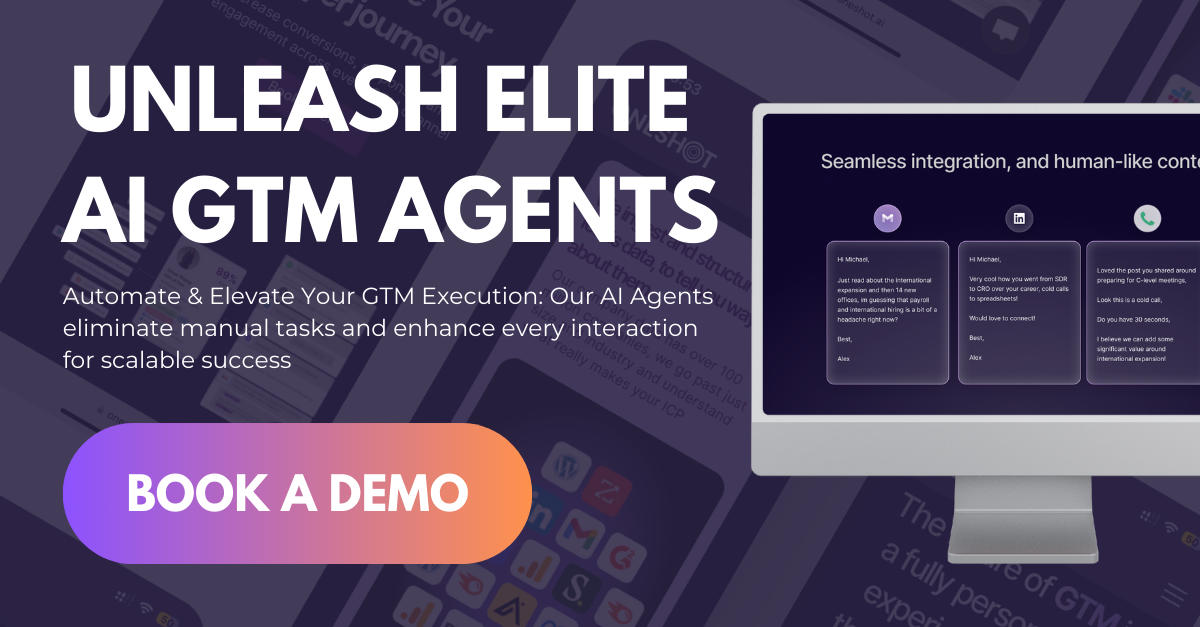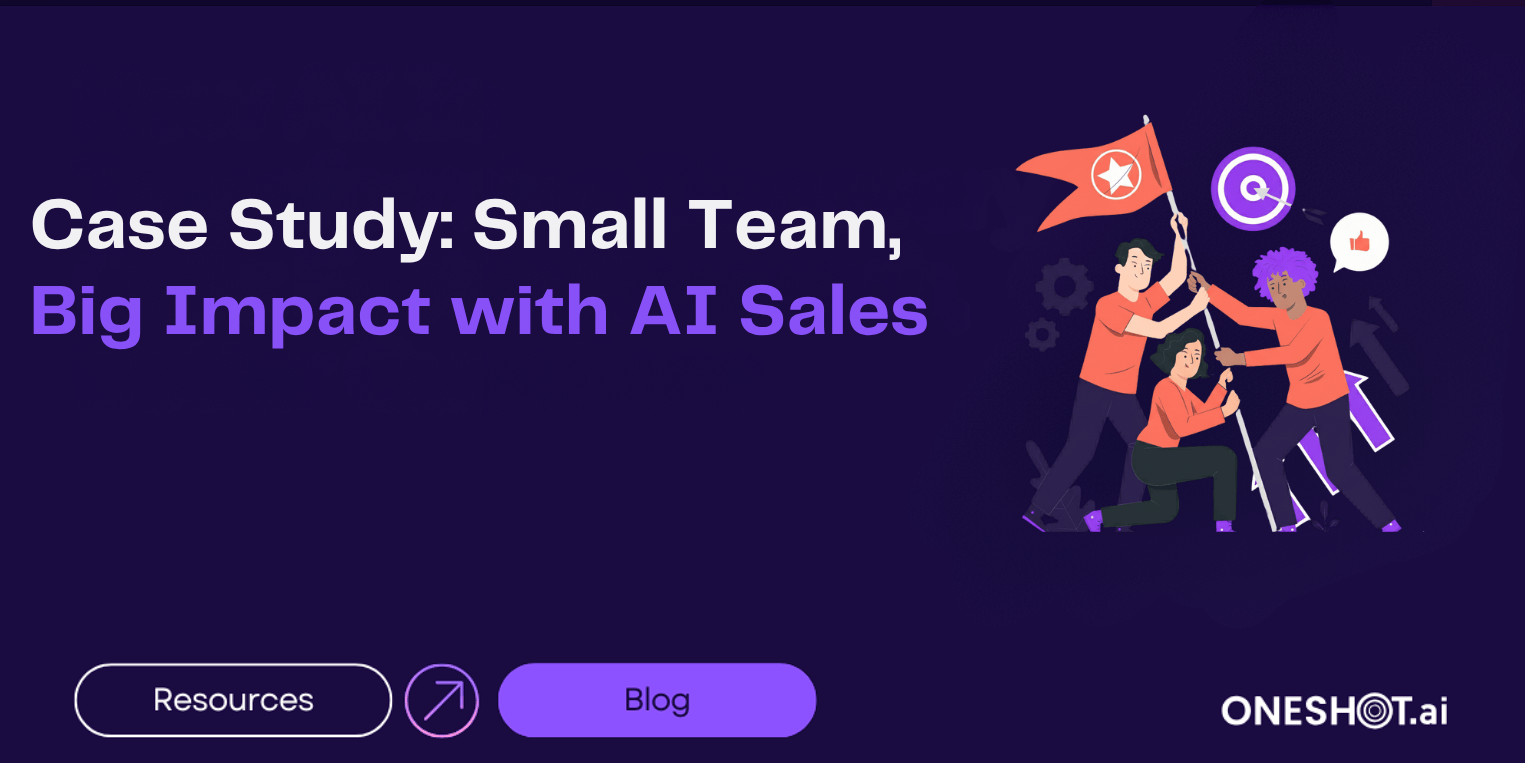Why Does AI-Powered Sales Matter for Small Teams in 2024?
What are the biggest outbound sales challenges for SaaS sales teams with under 10 reps?
Scaling outbound efforts is among the most challenging obstacles for small B2B sales teams with fewer than 10 reps. Bandwidth limitations make it hard to prospect, personalize, and follow up without sacrificing aggressive targets.
Traditional outreach tends to put teams in a numbers game—more calls and emails, but, in many cases, not better outcomes. That's where AI changes the math. Rather than depending on human ability, AI executes repetitive tasks, detects high-intent leads, and empowers reps with data-driven insights.
How is AI reshaping SDR workflows and outbound success metrics in today’s market?
The influence of AI on sales development processes has been significant. As Gartner has it, by 2025, 80% of all B2B sales interactions will be digital-first and feature AI as a core capability in enhancing reps. For small teams, that translates to fewer cold calls and more directed engagement, powered by actual buyer intent signals.
McKinsey also states that companies leveraging AI for prospecting generate up to 50% more leads and 40–60% lower customer acquisition costs. These changes demonstrate AI is not a nice-to-have—it's becoming necessary for competitive sales teams.
What data proves the ROI for AI-augmented sales versus traditional methods?
The ROI of AI-enhanced sales methods versus traditional methods is becoming clearer by the day - HubSpot’s 2024 B2B Sales Benchmarks data showed companies using automation typically get their response rates to be 20–30% better.
That's tremendous value, especially for teams with limited resources, as every extra win provides a larger and larger impact on pipeline growth. Instead of a headcount scale, we now have a capacity scale. For lean SaaS teams, AI provides the multiplier needed to compete with much larger companies.
👉 See how OneShot.ai can scale your team's capacity in sales → Learn More
What Was the Client Profile in this AI Sales Case Study?
The client of this case study was an expanding SaaS business with a four-member sales development organization. Pitted against bigger B2B competitors, their small team found it hard to meet the volume needed to regularly produce a pipeline. Each SDR was tasked with hundreds of prospects on a weekly basis, rendering it practically impossible to achieve personalization balanced with efficiency.
What were the specific pain points they faced with outbound prospecting?
Their greatest pain point was outbound prospecting. Though they had contact data at their fingertips using tools like Apollo, follow-up conversions were never consistent. Outreach was repetitive, messages were irrelevant, and open rates were faltering. The team was aware they needed to update their process, but couldn't double the headcount.
What KPIs or sales goals were they struggling to achieve before AI implementation?
KPI's such as booked meetings per rep and reply rates were much lower than target. On average, only 6% of emails got a reply, and the total number of meetings booked monthly by the team was only 15.
Pipeline coverage was too thin, and leadership was worried the team would not reach its quarterly revenue goals. AI provided an alternative for team members to break the cycle without burning them out.
How Did OneShot.ai Transform Their Sales Strategy?
The turning point arrived when the startup began using OneShot.ai to automate prospecting and outreach. With the Insight Agent, the team used automation to research prospects—tracking buying signs like job shifts, funding rounds, and product adoption news. This took hours of admin prep work out of the equation, allowing reps to spend more time on conversations rather than on admin work.
How did they personalize LinkedIn messages and email outreach at scale?
Personalization at scale was made possible by the Personalization Agent, which created customized email and LinkedIn messages based on the context of every lead. Rather than generic templates, each prospect was communicated with in relation to their job, company stage, or recent trigger event. For the first time, outreach both scaled and felt relevant.
What integration tools (e.g., HubSpot, Apollo) did they connect with OneShot.ai?
Integration was also effortless as OneShot.ai integrated directly with their current tech stack, such as HubSpot CRM and Apollo. Prospects were automatically poured into campaigns, and engagement insights fed back into the CRM to optimize continuously. The automation took out duplicated effort and minimized time-to-contact for inbound leads.
How did the Persona Agent ensure brand-authentic messaging even with automation?
Ultimately, the Persona Agent guaranteed that all messaging matched the brand's voice. While most of the outreach was automated, it was able to keep the tone, style, and authenticity that the sales team had really focused on. This combination meant that prospects didn't feel like they were talking to bots—they felt like they were talking to trusted advisors.
👉 Automate but don't lose your voice—Discover how Persona Agent works

What Tangible Sales Results Were Achieved After 90 Days?
During the initial three months on OneShot.ai, the SaaS team experienced a fivefold increase in outreach volume, along with performance improvements. Reply quality enhanced rather than fell off in comparison to past "spray and pray" strategies. By matching outreach to buyer intent, the team sent fewer irrelevant messages and increased qualitative conversations.
What were the open rates, response rates, and conversion uplift after AI adoption?
Email open rates leaped from 34% to 58%, and response rates doubled from 6% to 12%. Most significantly, conversion rates to booked meetings were up 3X, leading to 45+ quality meetings per month compared to the previous average of 15. These statistics presented leadership with definitive proof of ROI.
How was time efficiency improved across the SDR team?
Gains in efficiency were also notable. Reps saved 8–10 hours of week during manual research and drafting, according to Reps. They spent it instead on live calls, discovery calls, and warm account nurturing. The better balance of automation and human touch maintained burnout levels low while pipeline activity was high.
What was the revenue growth impact or pipeline improvement after implementation?
Earnings results were similarly reflected in the change - pipeline generation increased by 4.5X within a quarter, providing the theoretical breadth of coverage for the company to hit targets comfortably. Programming engagements resulted, for the most part, in a stronger initial engagement; the deals hastened through the funnel, shortening the sales cycle by almost two weeks!

👉Want these results for your own team? Get a demo now.
What Lessons and Tactics Can Other Small SaaS Teams Apply from This Case?
One of the important takeaways in this case is that AI-powered outreach isn't exclusive to big companies. A four-member sales team can experience disproportionate success when automation is strategically used. A minimum of 2–3 SDRs is usually all that is needed to tap into the benefits of OneShot.ai, as long as they are working with outbound at scale.
What tips helped this client scale AI without losing quality in prospect communications?
Another insight is the necessity of combining automation with authentic personalization. The client bypassed robo-sounding messages by using the Persona Agent and previewing AI versions prior to sending. This helped prospects get a sense that they were noticed and heard, and not merely targeted.
How do you balance performance metrics with genuine personalization using AI syncing?
Small teams must concentrate on one or two KPIs that are most important, like booked meetings or pipeline created, instead of attempting to optimize all at the same time. By aligning AI agents with certain results, the startup made efforts focused and trackable. This strict regimen enabled them to scale outreach while keeping quality intact.
👉 Discover how real personalization with AI works in our exclusive post.
How Can You Replicate These AI Sales Results with OneShot.ai?
There is no need to rethink everything to give AI-driven sales a try. The first step is to connect OneShot.ai to your CRM and lead sources so you can start swimming in intent signals. Once that is done, the Insight Agent enriches prospect lists immediately, providing context for better targeting.
What training or onboarding time is required with OneShot.ai?
OneShot Onboarding is inherently lightweight. For most teams, we can be completely onboard OneShot.ai in less than two weeks, with training sessions to help SDRs on best practices, and implementation will be fast and intuitive since we automate many of the heavier milestones.
What trial/POC options are available for smaller B2B sales teams?
For small B2B sales teams, our trials and proof-of-concept options can help you validate your ROI before scaling, so company leadership can see the positive benefits quickly, while you simultaneously allow reps to see how much time and effort they save through automation. After that, proliferating usage through your campaigns is easy.
👉Start your AI sales journey today with a free demo.

Conclusion
Small sales teams do not require large headcounts to succeed in the B2B market today, as this case study demonstrates. With AI software such as OneShot.ai, lean teams can achieve 5X outreach, double response rates, and significantly increase pipeline in a matter of months.
The combination of automation and personalization enables reps to concentrate on high-value conversations while AI does the heavy lifting. For small SaaS businesses and startups, this strategy puts them on an even playing field with bigger players. The message is simple: with AI, small teams can have a big impact.
👉 Start your AI sales journey today with a free demo.
FAQs
1. How can small sales teams use AI to boost performance?
Small teams can use AI tools to automate lead generation, qualify prospects, and personalize outreach—helping them achieve enterprise-level efficiency with limited resources. AI handles repetitive tasks so sales reps can focus on building relationships and closing deals.
2. What are the benefits of AI in small business sales strategies?
AI enables small businesses to compete with larger firms by offering predictive insights, smart automation, and data-driven decision-making. It enhances customer engagement, shortens sales cycles, and boosts overall productivity.
3. Which AI sales tools work best for small teams?
Top AI sales tools for small teams include HubSpot AI, Apollo, OneShot.ai, and Zoho SalesIQ. These platforms provide lead scoring, automated follow-ups, and personalized content generation—empowering small teams to sell smarter.
4. How can AI improve sales forecasting for small teams?
AI uses historical data and real-time analytics to predict future sales trends. This helps small teams prioritize leads, manage pipelines efficiently, and make more informed business decisions.
5. Can AI sales automation increase revenue with fewer team members?
Yes. AI sales automation allows small teams to engage more leads, reduce response times, and close deals faster. It scales outreach without hiring additional staff—leading to higher revenue per rep.
6. What are real-world examples of small teams achieving success with AI sales tools?
Many small teams have used AI to achieve big results—such as doubling lead conversions or reducing manual workload by 60%. Case studies show that even startups can outperform larger competitors by integrating AI into their sales workflow.








